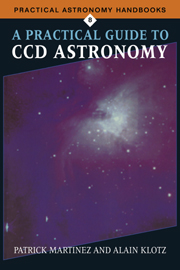1 - CCD equipment for astronomy
Published online by Cambridge University Press: 27 October 2009
Summary
From photography to CCD
The first observations of the sky relied on the naked eye. In this way, we can observe celestial objects to the 6th magnitude, with an angular resolution in the order of an arcminute. At the beginning of the 17th century, Galileo showed us that, with the use of an optical instrument, we can observe much fainter objects with a better resolution. Hence, a modest 20 cm telescope allows observation, visually, of 12th-magnitude stars with a resolution in the order of an arcsecond.
At the end of the 19th century, the appearance of photographic film turned our vision of the cosmos upside down. Photography, coupled with large telescopes, allowed the observation of objects of the 20th magnitude thanks to the possibility of integrating light. The general public was thus able to see for themselves superb images from the celestial world. And is this not the usual starting point for amateur astronomers?
The quality of specialized photographic films for astronomy has continued to improve, especially during the 1970s, thanks to the hypersensitization of finegrain films. Bear in mind that the grains, whose average size is about 5 micrometers (5 thousandths of a millimeter), are the elementary points that form the photographic image.
The 1980s saw the rise of CCD cameras, which replaced photography in astronomy. CCD stands for charge-coupled device. A CCD camera takes the form of a box equipped with a transparent window inside which is located in the CCD chip.
- Type
- Chapter
- Information
- A Practical Guide to CCD Astronomy , pp. 1 - 54Publisher: Cambridge University PressPrint publication year: 1997

